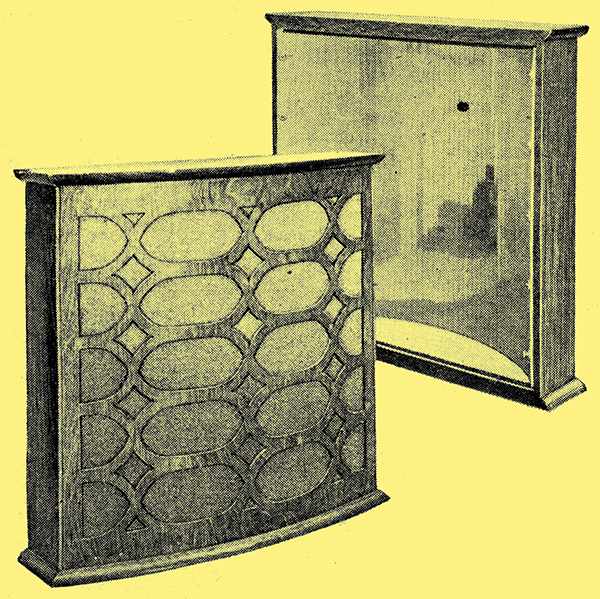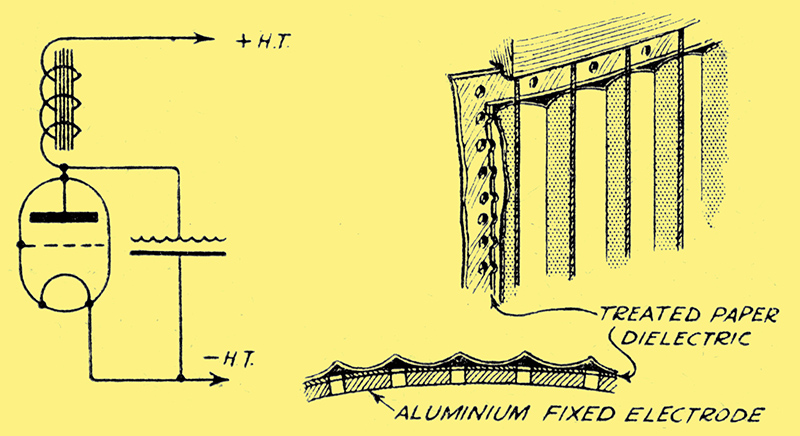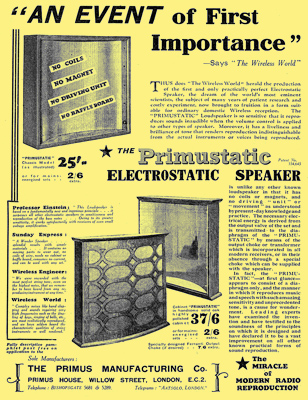|

Front and back views of the 'Primustatic' Standard model loud speaker.
Readers of this journal are already familiar with the principles underlying; the operation of the electrostatic loud speaker, but hitherto few opportunities have occurred in this country of obtaining; practical experience with reproducers or this type. The fact that the British-made 'Primustatic' loud speaker, shown at Olympia last autumn, is now in production, is, therefore, an event of first importance, for recognition of the advantages of the electrostatic loud speaker is, in our opinion, long overdue.
It is in the reproduction of the higher frequencies that the electrostatic loud speaker shows its superiority over other types. The extremely low inertia of the foil diaphragm is also favourable to the reproduction of transients in which the 'Primustatic' excels. Complex noises like hand clapping and sounds requiring very high frequencies, such as the jingling of keys, ringing of bells, etc., are most realistically reproduced, and we have seldom heard the characteristic qualities of string instruments so well rendered.
Measurements showed that there was a ready response to frequencies up to at least 15 kHz (the highest frequency available from the oscillator used). At the other end of the scale the output was well maintained down to 250 Hz, but fell off rapidly below 150 Hz. The bass response can be improved by experimenting with the matching between the loud speaker and output valve impedances, but the amplitudes which would be required in the bass to balance the excellent acoustic output in the upper register could not be obtained without rattling and possible damage to the diaphragm. Nevertheless, the response goes down low enough to give perfectly natural speech, and many people prefer the light and delicate quality which it confers to music. The connoisseur will no doubt make experiments with a view to obtaining the benefit of the bass response of a moving coil in conjunction with the exceptionally good performance of the 'Primustatic' loud speaker in the reproduction of transients and high harmonics.
The design and arrangement of the perforated fixed plate and the fluted foil electrode have resulted in a degree of sensitivity somewhere between that of the moving coil and moving iron types of loud speaker. This has been obtained with polarising voltages of the order of 150 to 200 Volts, which is considerably less than is required for previous electrostatic types. It is, however, advisable to work with voltages in the region of 200 Volts, as with lower values there is a tendency to introduce second harmonic distortion at the lower frequencies.
Unlike loud speakers with inductive windings, the impedance falls with frequency, and this must be borne in mind when matching with the output valve. A special Ferranti tapped output choke is available for this purpose, and very full information regarding the output connections and the method of applying the polarising voltage from the HT supply to the receiver is contained in the instruction leaflet.
The dimensions of the standard model are 21in × 19¼in × 5¼in, and the convex front was found to give far less focusing of the high frequencies than is usually the case with cone diaphragms. As a result it is sometimes difficult to tell from which direction the sound is emanating - a distinctive effect which is well suited to many types of transmission.
The makers are The Primus Manufacturing Co, Primus House, Willow Street, London, EC2.

Constructional details and method of connecting the 'Primustatic' loud speaker.

Advert from June 8, 1932.
|